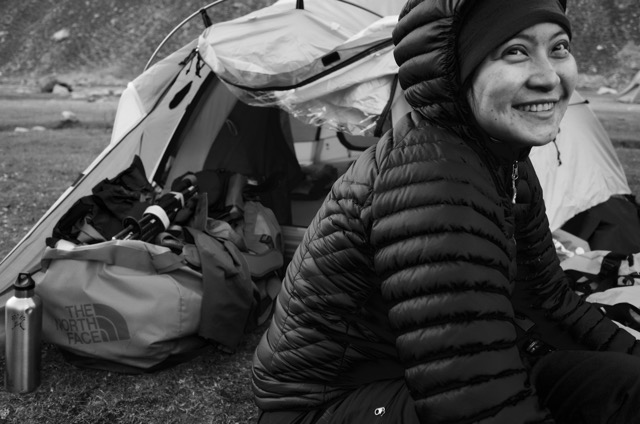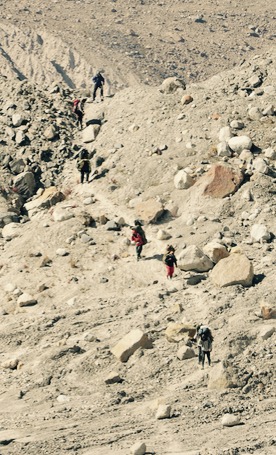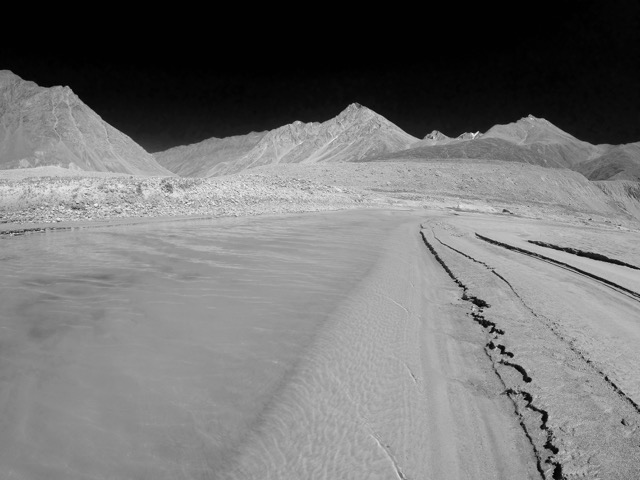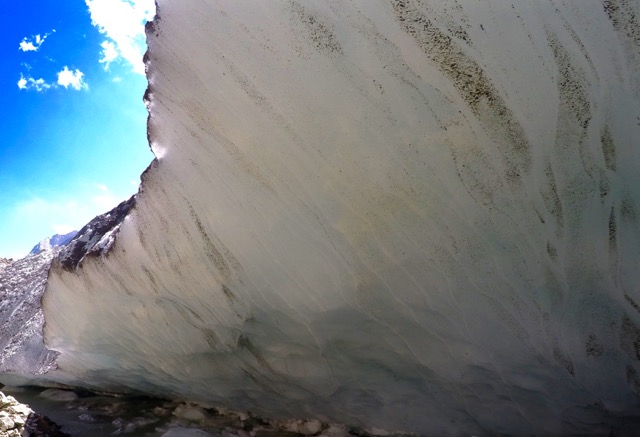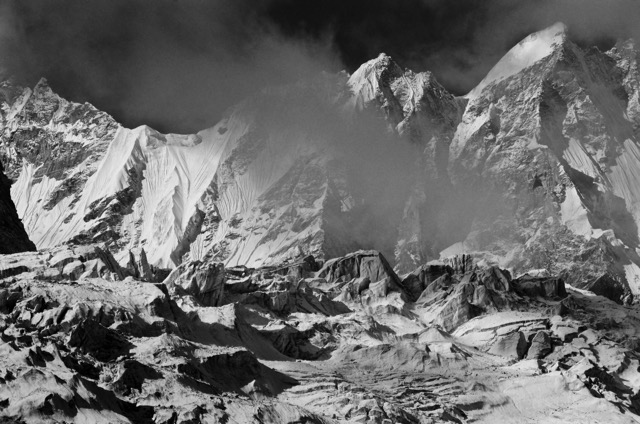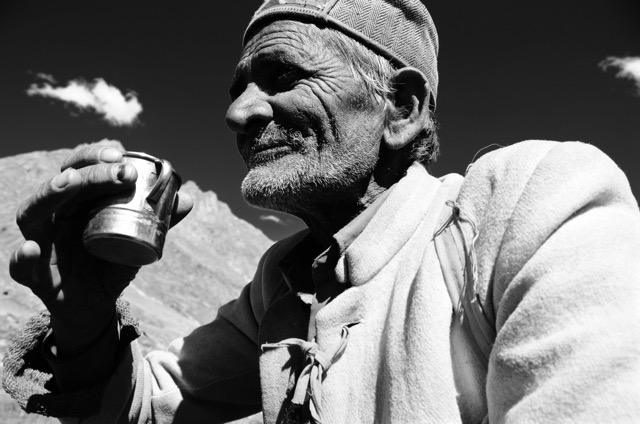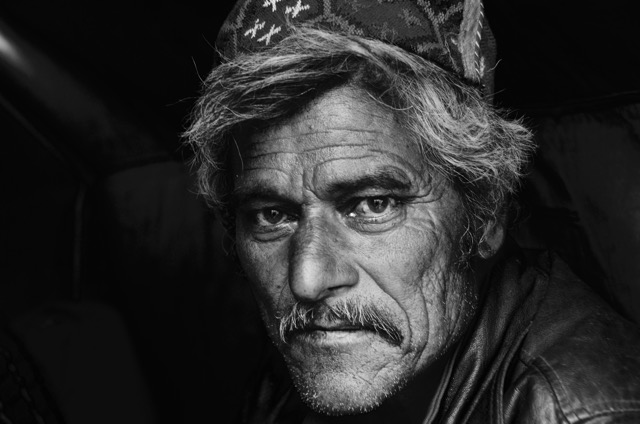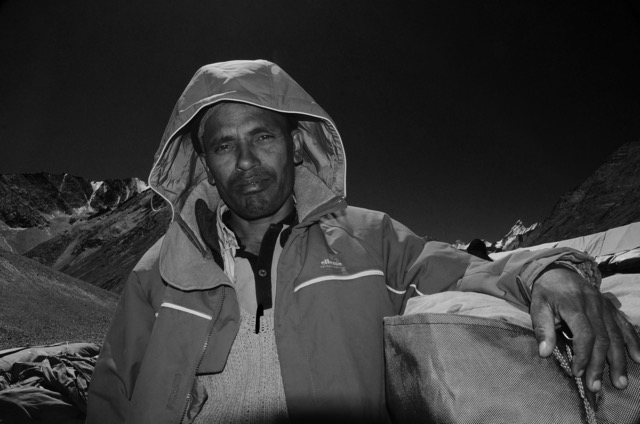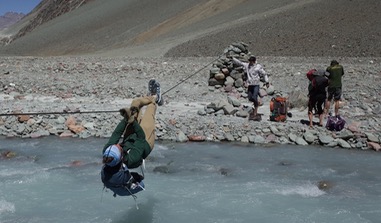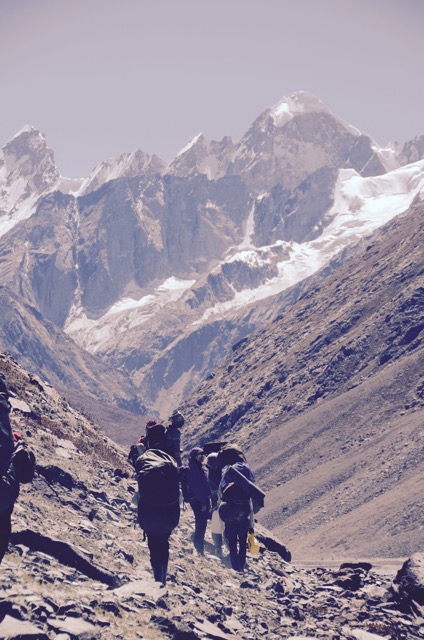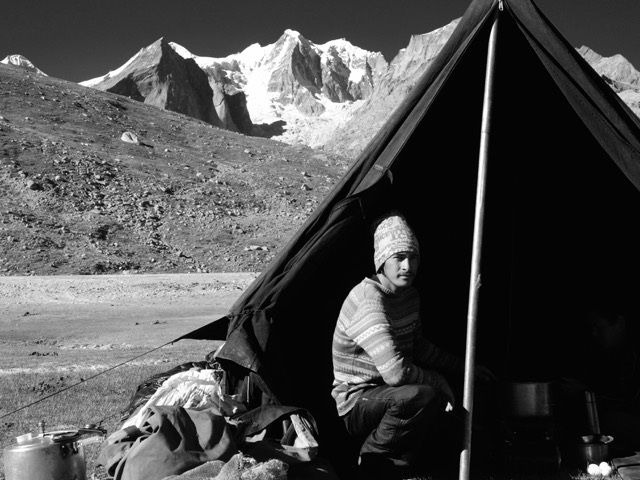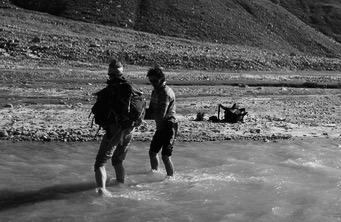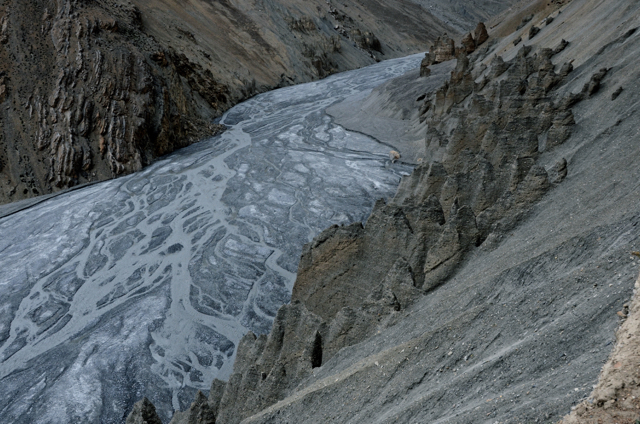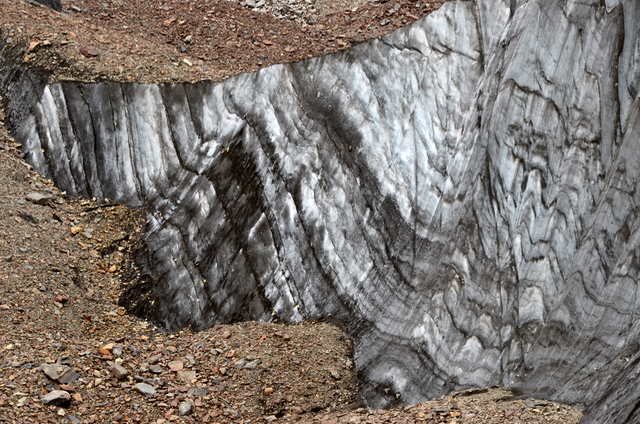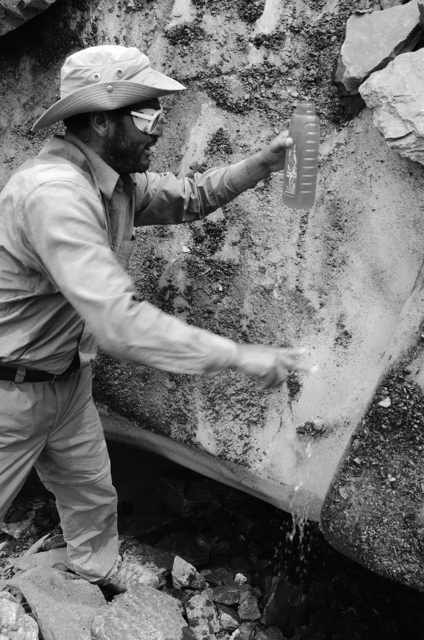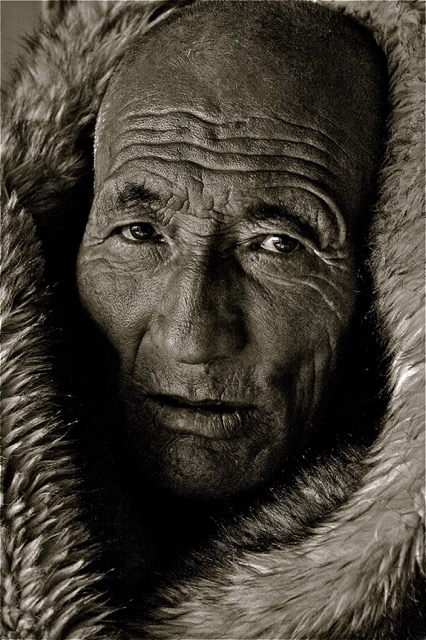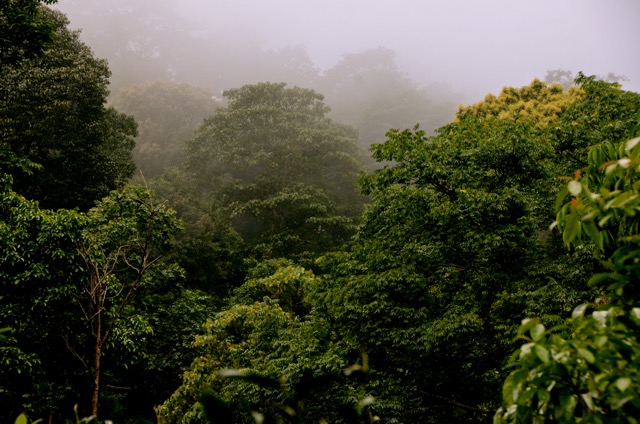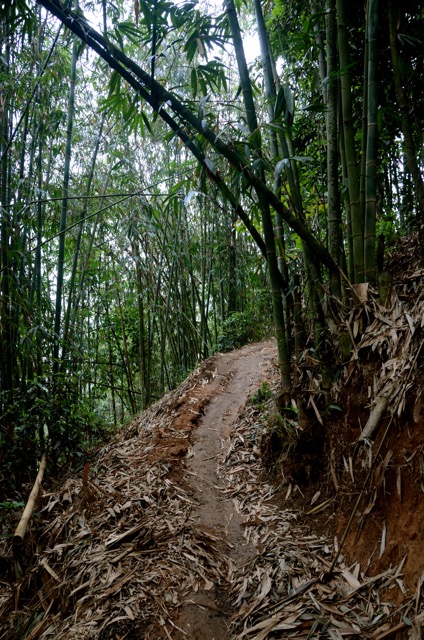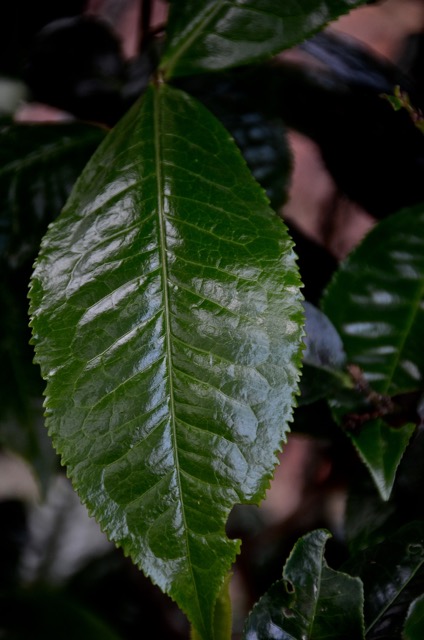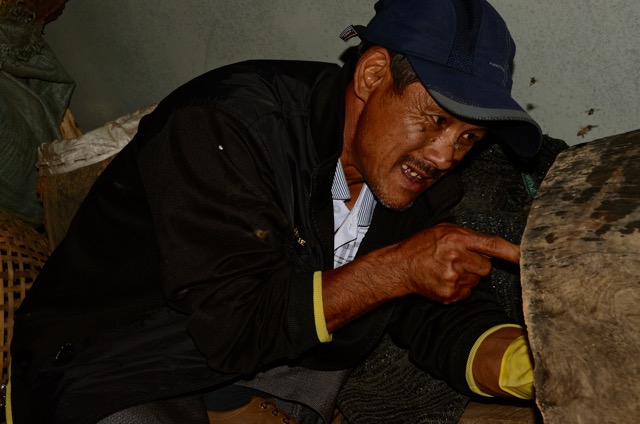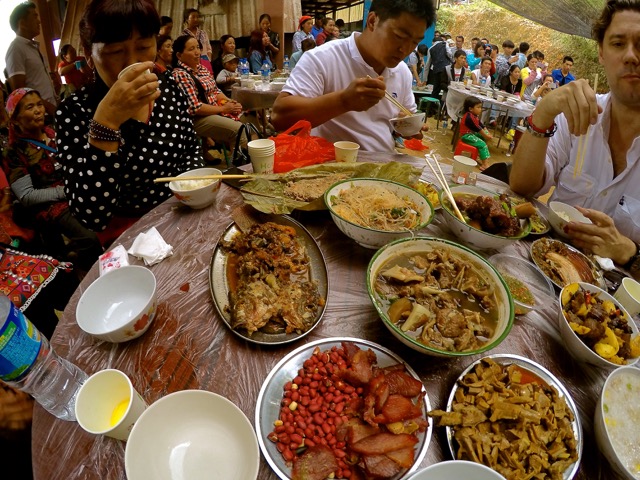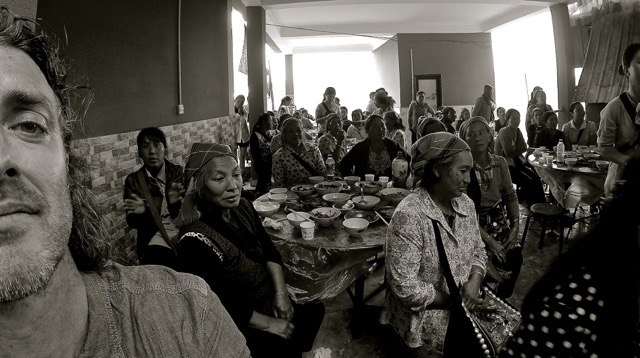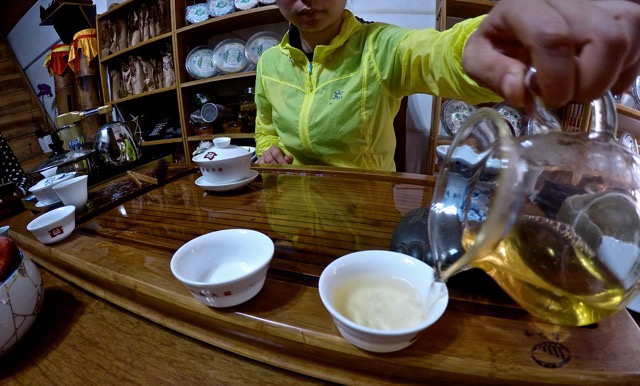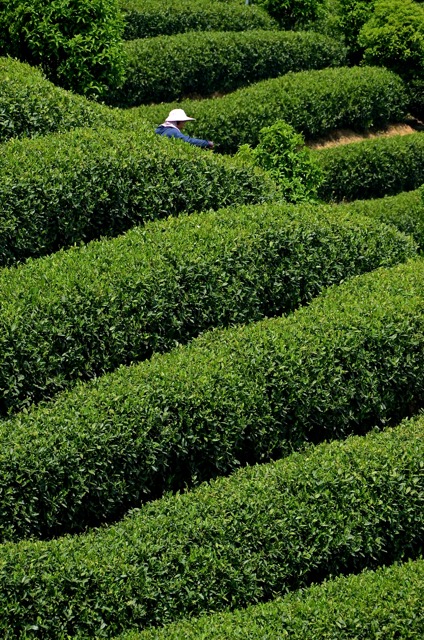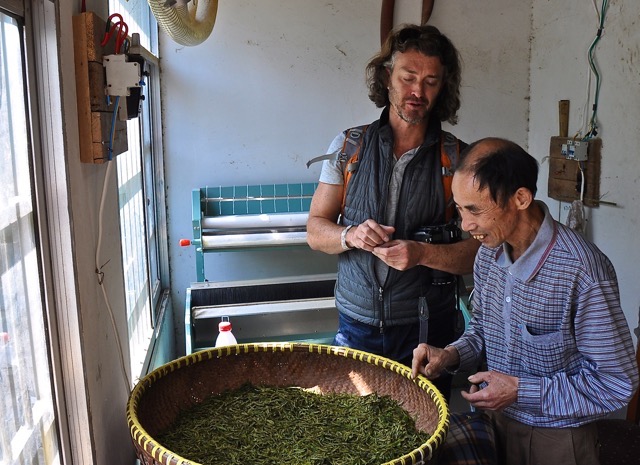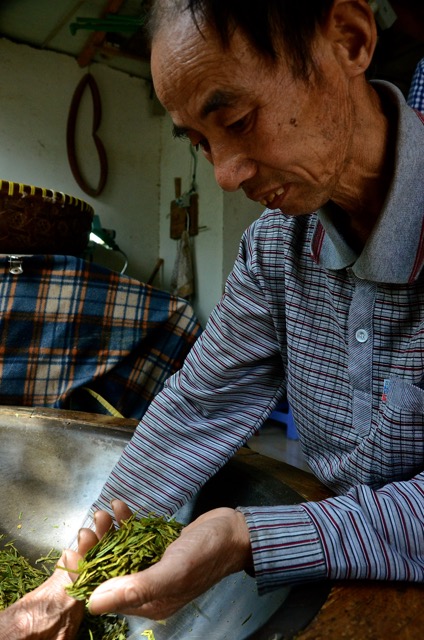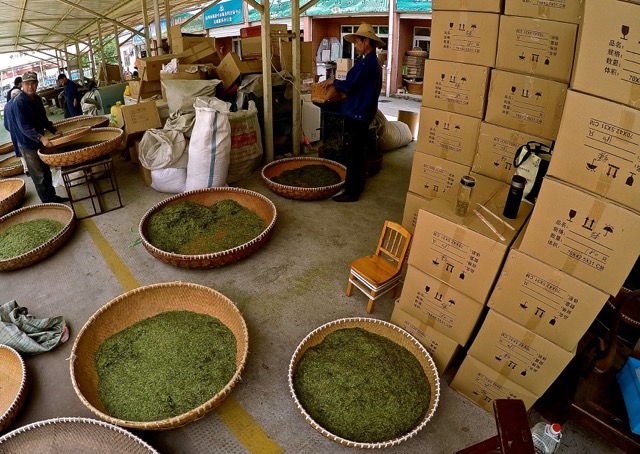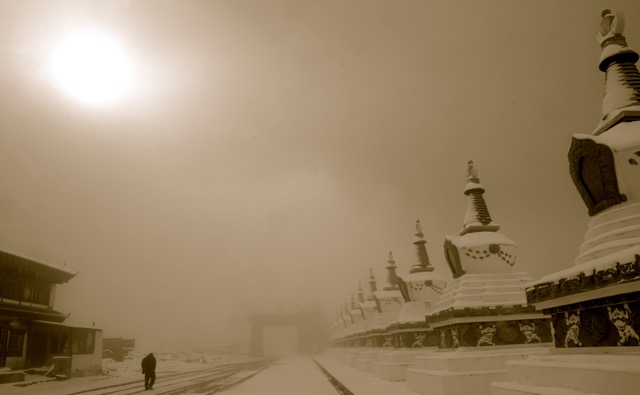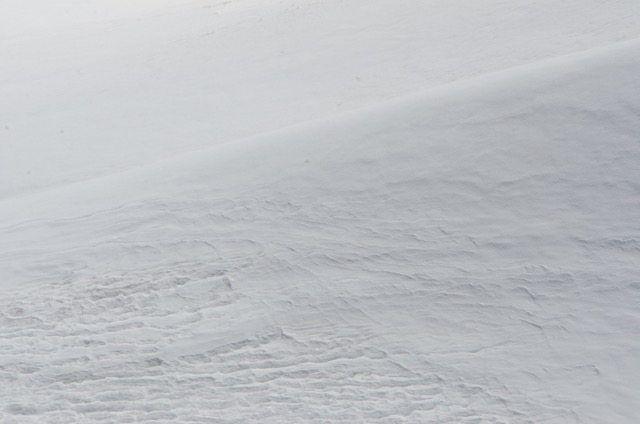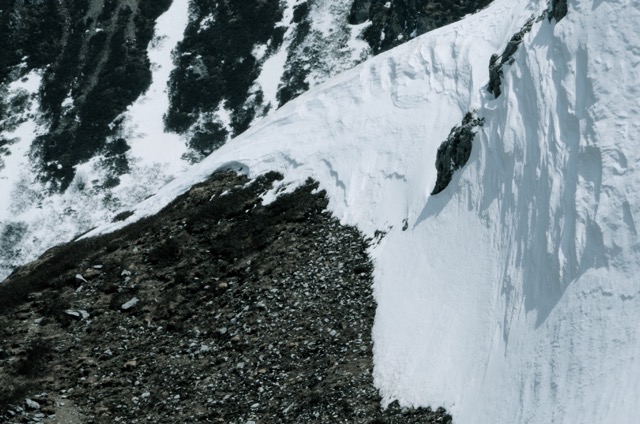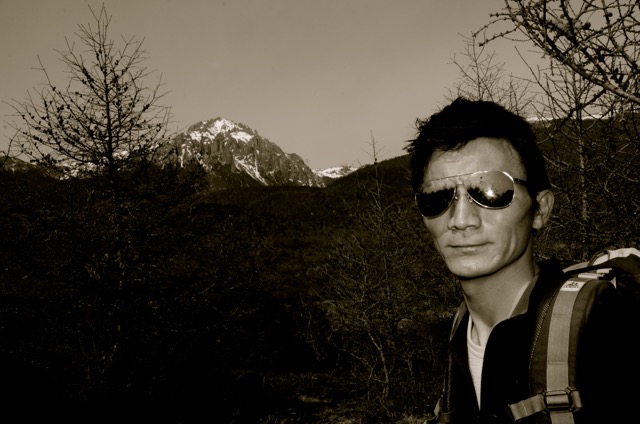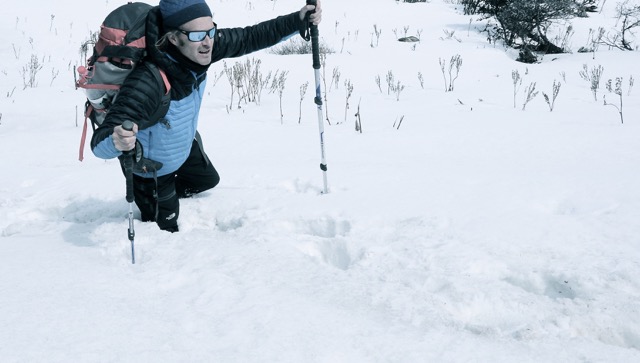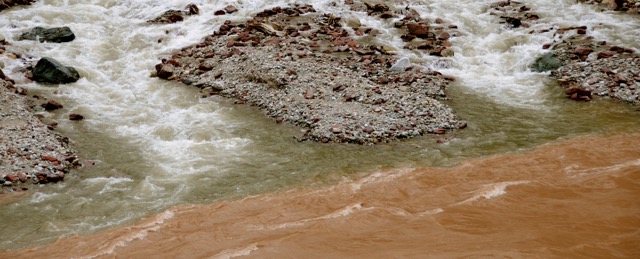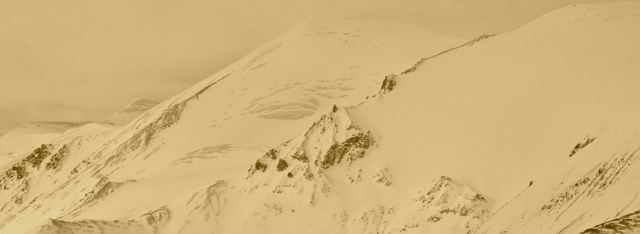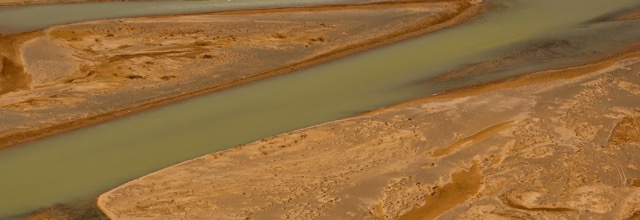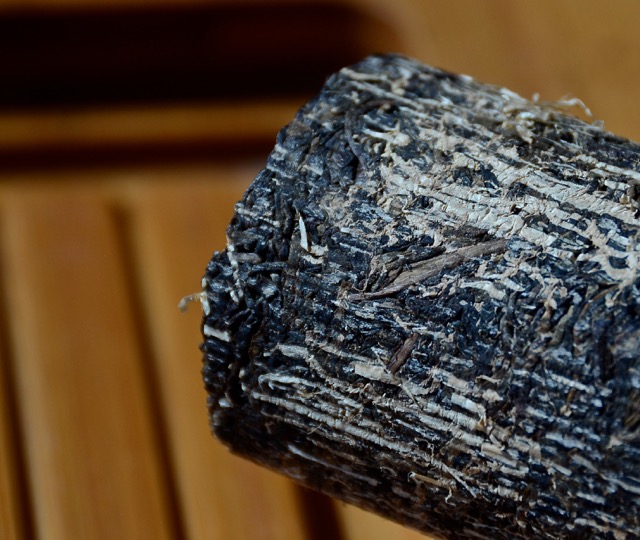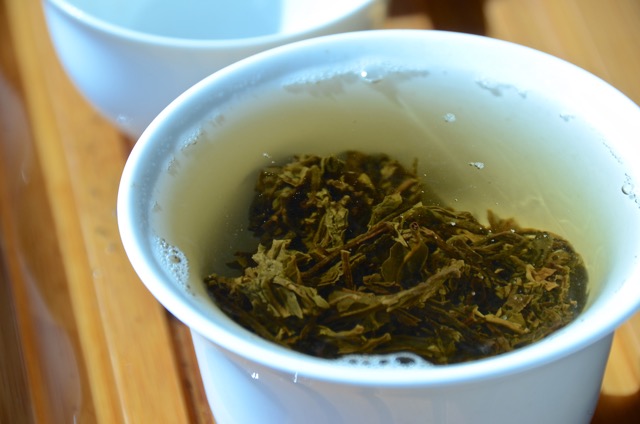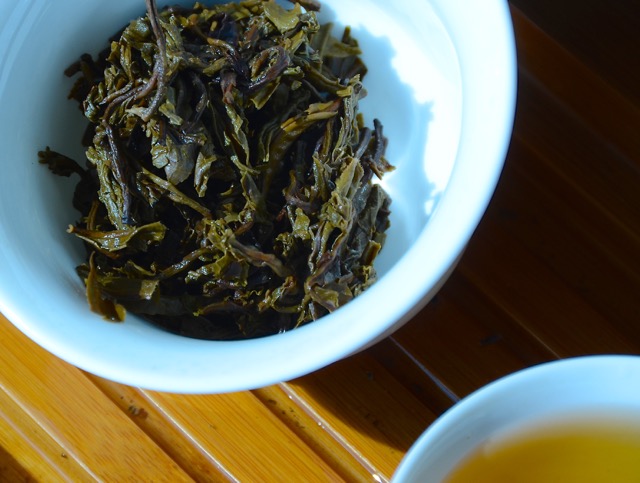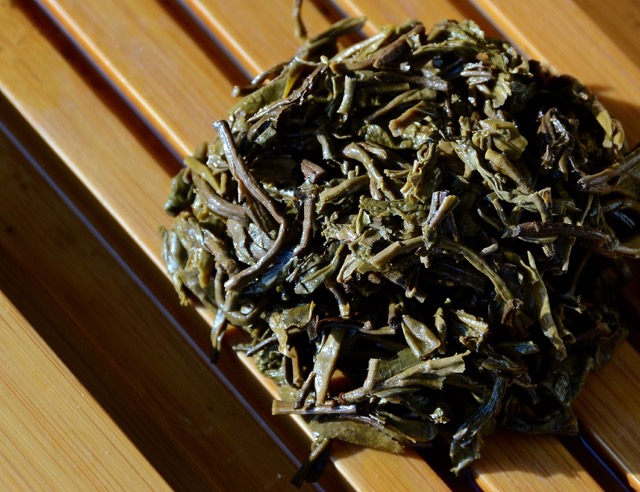Hangzhou’s immensity is somewhere north of us as we move south and then east speeding through dark fields and villages. We are zipping on one of the latest high-speed train lines away from the coastline and heading inland into darkness and the murky smoke trails that seem to hover. I’m in tenuous touch with my contact ‘Cindy’ who tells me to get off the train at Shangrao and then grab a cab to her clan’s lands at one of the epicenters of tea lore, Wuyishan Mountain in Fujian.

A first sip when arriving of the local specialty tea is always vital. Here a cup of Da Hong Pao is served up.
We’ve left the stronghold of Long Jing, its three precious roasts, and the stooped and wonderful little figure of Master Ting and we are moving inland into old tea lands where the teas are darker. Wuyishan is where some of the world’s dark delights originate and where some of the most complicated Oolongs go through their various stages of manipulation and art.

A little sniff or two never hurt either…many teas may be made simultaneously.
Frank and I are ready at the Shangrao station to hop out. Our dinner consisted of some peanuts, a beer, a piece of fruit and in my case some sunflower seeds. We are edgy and eager. Night has long taken over the sky and now we must hop in a “legal cab” (Cindy’s words) and drive the 2 hours to Wuyishan’s epic Oolong fields where we can then relax.

Cindy and Frank enjoy some moments with the precious Wuyishan leaves
Our legal cabby, who is driving a green Volkswagen Santana – after having negotiated a price with us that is actually less than what I’ve been told to expect – stops on the outskirts of town and transfers us to his buddy who is driving a distinctly black coloured Mazda. He tells us that this will make our ride more comfortable. I growl and moan while the two ‘buddies’ do their best to convince us that they are arguing. There seems no choice and after dropping some carefully placed expletives about the “system” here I make a show of photographing their license plates, announcing that I will send these photos to my contact in Wuyishan to ensure no little mishaps occur before we’ve sipped from the source. Frank looks to me and I look to him imploring him to simply have faith. It is often the way in this part of the world. Big, modernistic cities, and the accompanying ‘ease’ are falling behind us and that means adventures increase tenfold.
Wuyishan is hallowed ground for any who cherish tea. Home to the ridiculously pricey original Da Hong Pao (Big Red Robe) roasted ‘stone’ Oolongs, we are entering into lands that are as fabled as they come when dealing with tea. One of the most expensive teas in the world when originating from a select few terraces cut into stone and produced by one of the heralded masters, it is a tea layered in multiple stages of flavor and nuance and multiple spectrums of production. Oolongs here are created with a series carefully orchestrated stages, each carefully crafted and manipulated according to what has been passed down and what is dictated. Mere grams of a good Da Hong Pao can go for hundreds of dollars. It is sacred, sacrosanct and at times slightly ridiculous, but then I’m game to this lunacy of the leaf.
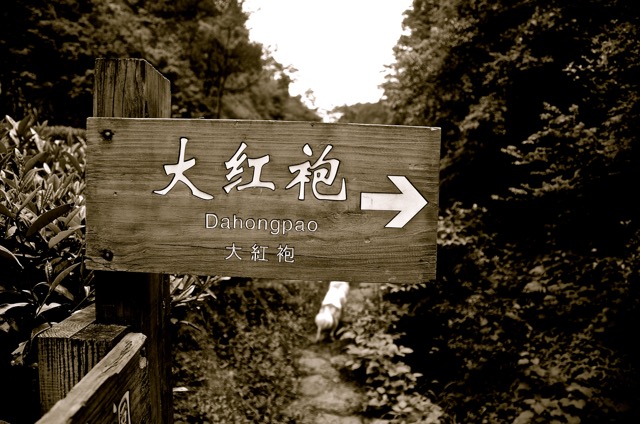
Cannot get more explicit that a sign…we’ve arrived
Our arrival in the middle hours of the night is the only thing on the mind. Arriving to Wuyishan at night, even with lights dimmed, it is clear that tea’s symbol for ‘cha’, dominates storefronts, door panels, hotel windows and even signposts. Cindy, who I’ve never met before, is waiting for us patitently. She is in the midst of tea production season and the shift work (fresh tea leaves are impatient fellows) has left its mark on her. She is blearly eyed, clearly ripped on tea, but still as generous and welcoming as a family member.
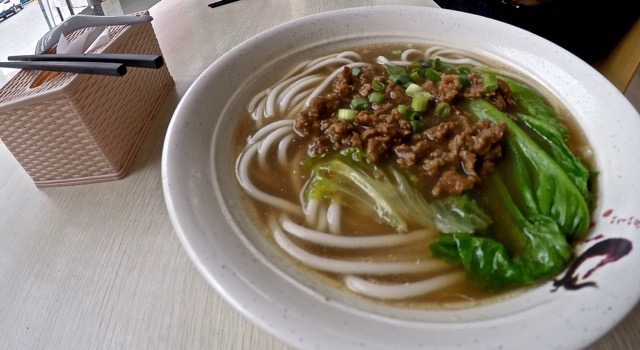
Our morning fix every single morning while in Wuyishan.
We sleep the sleep of exhausted addicts: wiped out and keyed up simultaneously. Much as the Da Hong Pao prices, legitimate rarity and ‘at the source’ beckon us from bed the next morning I’m more interested in another of the region’s beautiful creations; another in the roasted rock Oolong family: the Rou Gui.
Many say that Oolongs have found their ultimate expression in Taiwan where technique, art, and volcanic soil have contributed to something sublime. Difficult, detailed, and in need of master makers who understand the timings for each stage of production, Oolongs are perhaps the most complicated of teas to create …and some would argue, appreciate. Wuyishan is one of the true origins of Oolongs and it is in the very blood flow and genes of the locals. The Da Hong Pao, the Xiao Hong Pao (‘little red robe’), Tie Luo Han (Iron Monk), and my beloved Rou Gui go through similar processes with varying degrees of perfection.
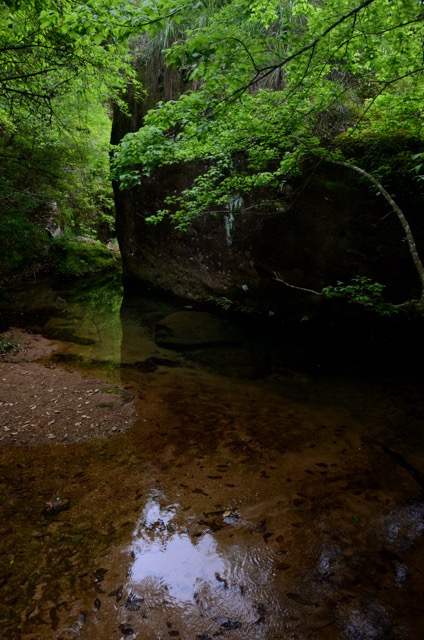
The landscapes reflect the care to retain the sanctity of the place. Great tea-scales inevitably have great water sources.
Our first morning comes in with a bowl of noodles in a little restaurant across from our hostess’s tea shop. The whole town is afloat in Oolong teas and buyers. Locals are racing between the fields, their little production bases, and their tea shops. Mornings are spent watching the sky, as the leaves should be plucked in the morning after the morning dews have evaporated but before the sun’s beams hit the leaves – at least that is the ideal. There are other varying times of acceptable harvesting but for Oolongs and for those that follow and create the Oolong path there cannot be too many variations. Here, Oolongs rule and their every step of production is vital and practiced. Every stage has a master and every master has an overseer and that overseer is an overlord who ensures that the entire procedure flows in a way that is consistent and utterly predictable. With Oolongs, accidents don’t often lead to ‘miracle’ teas the way it can with others. Great Oolongs are entirely a ‘product’ of superb procedure, wonderful soil, and consistent care.
A quick morning visit to Cindy’s tea shop and some introductions to what this region’s teas are all about is made. First off some of the venerated classic: Da Hong Pao. Frank and I both have bags that have been unceremoniously stuffed under chairs in the little shop space. Cindy’s husband is a quiet and comforting presence who is at once provider and finder. He is also a collector of purple clay tea pots and paraphernalia and one of his prized pots rests on the tea table just to my right hand. It is burnished from years and perhaps decades of use and it gleams like a little maniac. Oolongs, ‘black’ teas, post oxidized teas (Puerhs) can be served in the porous purple clay of Yixing with the informal law that “one kind of tea for one pot” being crucial to adhere to. Flavonoids and vegetal proteins lodge inside with repeated additions of fully boiled water and a tea will ‘cure’ or flavor a pot over time so that it becomes the ideal vessel to serve a particular tea from. On this morning Cindy uses a simple white ceramic gai wan or flared cup vessel for ease of examining colour and rapid fire infusions. Rapid fire they are, but with Cindy every serving is something fresh and perfect, though she in all of her modesty claims that she is “only someone who knows tea a little”.
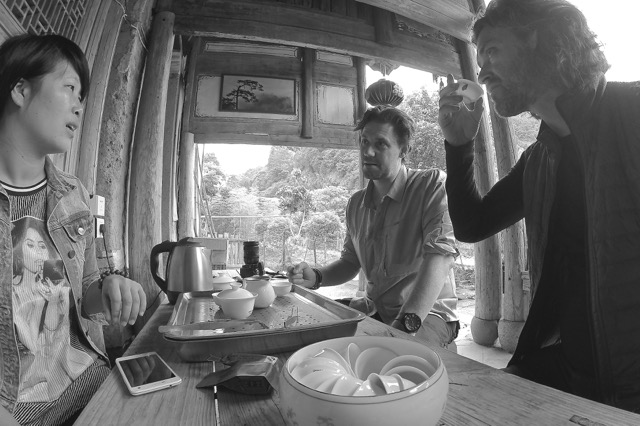
Frank and I taking yet more servings of tea. This little tea session was taken at a little monastery within the Wuyishan protected area.
Cindy is made of tea it seems. Rampant energy, talking of nothing else, she knows tea from the soil to the very skin of the leaf and through the various stages it is a subject that is part of her. Her entire family for generations has produced Rock teas (called ‘yen cha’ locally), named for the fact that the teas generally grow in small terraced plots amidst stone and shadows where the teas must struggle to find a root-hold in the soils. Those that survive are strong and those that don’t, ebb away to wither.
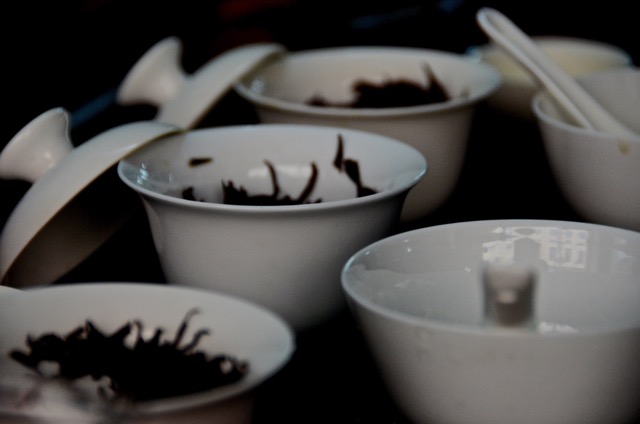
Action central in a tea kind of way
Our firsts sips are dark brooding cups that push the palate this way and that with its baked essences. Frank holds his tongue and comment until a few more cups are poured in. While a classic the Da Hong Pao hits my own very subjective tongue in a way that is simply too much. A gorgeous rich tea that seems a little too complex perhaps for my palate. My request for a quick nip of Rou Gui is an entirely selfish one but one I can at least defend as something for Frank’s palate education. It is another of the famed rock teas but perhaps a little less famed than the venerated Da Hong Pao. Slightly less complex it has hints of nut and of the baking/roasting process and for whatever reasons it has always been a kind of favourite of mine within this complicated realm of rock Oolongs.

Some of the fabled terraces in Wuyishan
Our sips reveal these qualities and the offerings of Rou Gui that we are poured are that which we could scarcely afford (even though Frank and I who spend frightening amounts on teas we deem good enough). Smooth, strong and a taste that is reminiscent of the soya bean powder of Japan, known as ‘Kimako’. Slight roasted hints of nut without any sharp edges nor overly complicated layers. If copper could be sweetened with a hint of sugar cane and enforced with baked nuts, my mind’s palate tells me that it would taste a bit like the Rou Gui. Might sound a little disturbed but that is where it is at for someone who lives tea. Tea’s flavor ranges are enormous. The soil, the oxygen levels, the process, the hands, the heat, the day, one’s own palate will all affect a ‘taste’ to varying degrees.

A man (under watch of a guard) brings precious leaves out of the Wuyishan Mountains…precious stuff!
Sips and days later and we have taken in an ever widening assortment of teas; meals at all hours in houses, shops and fields and finally a day comes when the timing is right to see one of the homesteads where most of the full processing is done.

Stone teas struggle to find a root hold but when they do, they are the basis for rare masterpieces.
Old homesteads that were once within the actual Wuyishan Mountains were moved by government to nearby lands in past decades to ‘protect’ and preserve the mountains and their very vital leaves. Cindy’s family now occupies a complex of homes, and each family group has their role to play in the process of the annual offering of semi-fermented teas that fetch wondrous amounts of cash.

The soil at the base of the root system allows for oxygen to pass through and for moisture to drain…perfect conditions.
We enter into a compound where leaves lie on carefully laid out netting and sheets during the first of their withering cycles. Smells of food accompany the sight of the sleeping bodies of shift workers passed out on couches. Shift work is a 24-hour cycle during which the leaves rule.
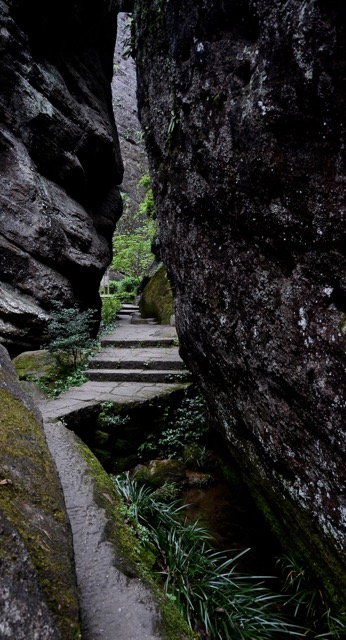
Getting to and into the Wuyishan reserve is by pathway and pathway only.
We head upstairs to where another withering room for the second cycle lies tucked away and then wander into a special room that I’ve been longing to see. It is the room where fermentation (in this case partial fermentation) takes place. Here the smell is as close to a narcotic of baking and vegetal sweetness as I’ve ever encountered hits the system. It is a golden smell and a golden room in my frame of reference. Fermentation and its manipulation is what makes an Oolong, an Oolong. Known in China as a ‘blue’ or partially fermented tea, it is the tea that occupies the middle kingdom between green and red or black offerings.
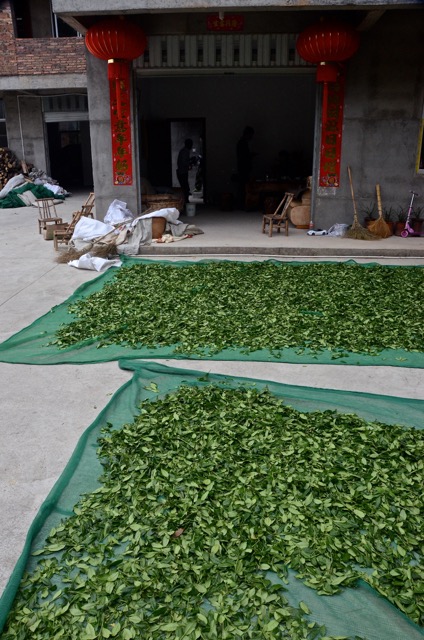
Withering leaves for their first cycle lie outside the main house
Here, fermentation is encouraged with heat. Heat is generated by way of smokeless bamboo charcoal which is blown through a long pipe into a huge cylindrical silo, in which Leaves are piled high. The silo is able to rotate which thereby turns and ‘flips’ the tea leaves within to open up and allow equal amounts of heat and oxygen to interplay.

A second withering session in an enclosed and shaded room
A master of this particular portion a heavy set young man quietly marches into the room to pull his hands through the leaves smelling them as they rest before his busy nostrils. He studies the edges looking for tell-tale signs of oxidizing and the slight red tinges along the leaves length that accompany this process. He smells (he explains later that there is a smell when the “leaves are moving from one stage to another in their process”), and he feels for a suppleness in the stems and skin.
Sipping later just metres from where all of this frenetic on and off activity of caring for the leaves is taking place, Frank and I marvel at the concentrated focus that applies to the creation of an Oolong. It is perhaps the most complex tea to create well, needing master hands and an absolute adherence to a system. It needs too a marketplace that appreciates and will pay for the privilege of sipping the exquisite fluid.
Meals, love, family members and time are all needed in this process. Expertise is needed and a kind of fearless devotion and desperation almost are vital, otherwise traditions will simply be overhauled in favor of higher yield, faster production methods which seem to plague so much of Asian tea zones.
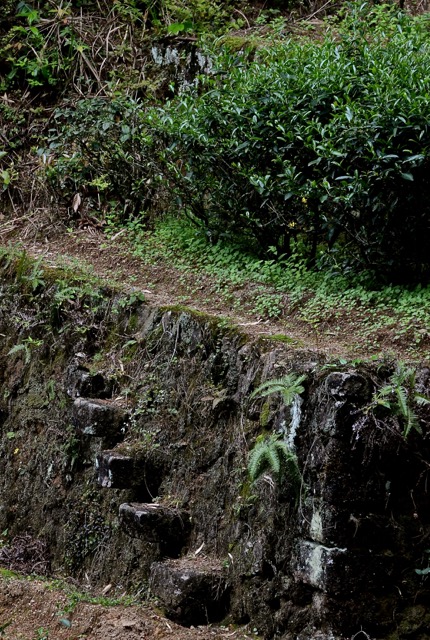
An ancient staircase built into a wall to access the terraces
For now at least it seems that the Rock teas are safe (though fakes and hastily created falsies abound) and the relationship between the hands and the leaves remains strong.
Purchasing a box of random and not quite so random leaves (in my case a good dose of Rou Gui from Cindy), Frank and I are off once again to the train station for yet another overnight journey north with a lot of tea and two bottles of red wine that ‘might’ be good. Yunnan’s Puerhs and my old home wait further west and south.
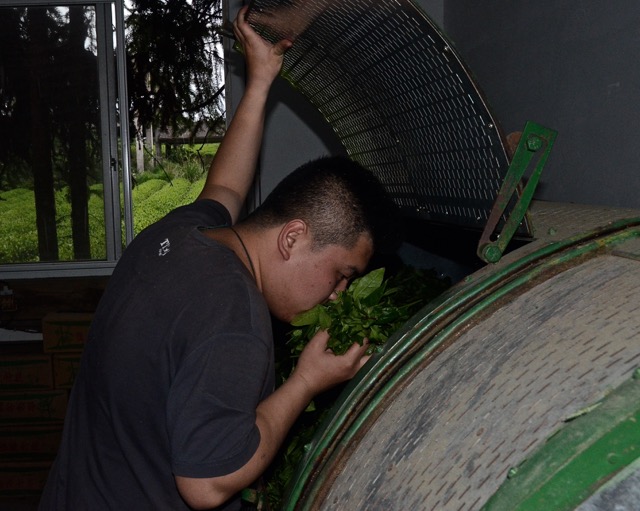
The young ‘master of the fermentation’ takes a nice snort of the leaves



